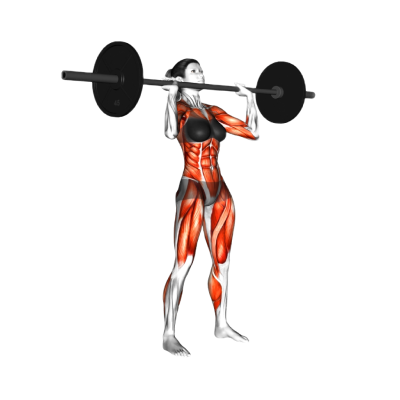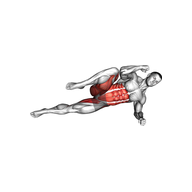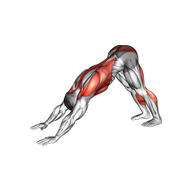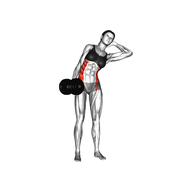What is a Medicine Ball Russian Twist?
The Medicine Ball Russian Twist is a popular core exercise that emphasizes rotational strength and stability. This movement primarily targets the abdominal muscles, particularly the obliques, and can also engage the lower back and hip flexors. It’s an effective way to improve overall core strength and enhance functional movement patterns.
How-to
- Sit on the ground and hold a medicine ball with both hands.
- Lift your legs off of the floor and use your core to hold yourself upright.
- Turn your body to one side and touch the ball to the floor. Repeat on the opposite side. Continue to move from side to side until you’ve completed 10 reps per side (20 reps total) for one full set. Rest, then repeat this set-rep pattern as many times as you need.
Muscle Worked
Primary Muscle Groups


Abs
"Abs" refers to your abdominal muscles, which sit at the front of your trunk between your ribcage and pelvis

Obliques
The obliques help you twist your trunk and support your core and spine.Pro Tips
- Lift your chest and keep a neutral spine during this movement. Don’t hunch your back and try to avoid sloped shoulders during this exercise. Letting your posture sag can put a lot of strain on your lower back. Make sure you lean back just enough to engage your core fully, but not so far that you tip over or your core muscles can’t support you. Holding a steady, braced position helps concentrate the tension of this exercise just on your abs and obliques.
- Avoid momentum, swinging your medicine ball quickly from side to side, or letting the ball pull you down. If you’re struggling to keep control, try to pause on each side to squeeze your obliques. This creates more time under tension than just letting your torso swing aimlessly.
Equipments
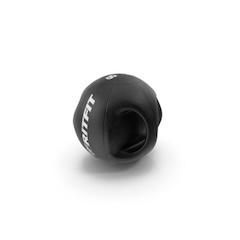
Medicine Ball
A medicine ball is a weighted ball that is used for strength trainingBenefits
- You Build a Solid Core: Medicine ball Russian twists work your oblique muscles like no other. Because your feet are up off the ground, they also target your balance and other core stabilizers. Getting an overall stronger core supports daily stability. Not only does this make most of your time in the gym and sports performance much easier, but it’s a great tool to have for everyday activities too. Although we may not consider it, things like fall prevention and lower injury risk as you age or being able to stand for longer periods on public transit all come from having good overall core stability. Exercises for your core are also conducive to better posture.
- Better Potential for Rotation: Your rotational power and strength are key elements in a lot of sports. If you’re an athlete who wants to do a baseball workout, for instance, being able to twist through your midsection is essential for both batters and pitchers. Thinking about swing patterns, we could easily apply this to golf or tennis too! By training your core to handle and generate rotational force, you help boost your athletic performance using a Russian twist with medicine ball.
Alternatives
The following exercises target the same primary muscles using different equipment:
Warm Up & Cool Down
Warm Up
- Cat-Cow Stretch: Start on all fours and alternate between arching your back (cow) and rounding it (cat). Cat cow gets your spine moving and gives your core muscles a gentle stretch so they won’t get too sore in rotational movements or other weighted ab exercises.
- Torso Twists: Standing with your feet hip-width apart twist your torso side to side, with your head following to look over each shoulder. You can keep your hands on your hips or let them swing around and follow your movement. Try not to let the arms take over the movement from your torso, though. This dynamic activity lets you loosen up your obliques and lower back for your medicine ball Russian twists.
- Standing Oblique Crunches: From standing, lift one arm overhead, and crunch it to the side, bringing your elbow toward your knee. Keep going for at least 10 reps on your first side, then switch sides.
Cool Down
- Seated Forward Fold: Sit with your legs straight out in front of you and reach forward to try and touch your toes. Rather than hunching your shoulders if you can’t reach, bend your knees for a modification. This releases low back tension and stretches your hamstrings, which can often get tight after core exercises.
- Kneeling Side Stretch: Kneel on one knee and stick the other leg out to the side. Bring your opposite arm to the kneeling knee up, then lean to the side of your extended leg, planting your other hand on the ground. This stretch lengthens the obliques and the sides of your body that work during twists.
- Child’s Pose: Sit back on your heels, bring your arms forward and sink your head and chest toward the floor. This relaxes your lower back, releases spinal tension and helps you breathe more comfortably.
FAQ


Get fit with Flex
Build muscle & lose weight fast for free.
Download for Free
Available on iPhone + Apple Watch

